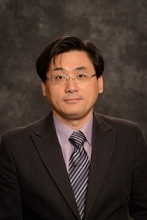MAE Seminar: Energy Conversion and Storage with Nanostructured Graphitic Carbon

Associate Professor
Department of Mechanical Engineering, Materials Science and Engineering
Texas A&M University (College Station, Texas)
Abstract: This seminar presents exciting opportunities with nanostructured carbon in energy conversion and storage. Graphitic carbon structures have excellent electrical/thermal conductivity and large surface areas, and carbon can be replaced or coordinated with other elements to gain electrochemical activities. In this seminar, Yu will discuss exemplary research activities with graphitic carbon in his research group. First, a carbon nanotube has been utilized along with conjugated conducting polymers and ionic conductors to harvest electrical energy from thermal energy, which is called thermoelectric energy conversion. Graphitic carbon here provides high mobility conduits, improving the electrical properties of their composite materials. When the powdery nanotubes are made into a solid polymer composite, junctions between the nanotubes are naturally intervened by the polymer and then the junctions can be controlled to obtain desired electrical properties of the composite. While the junctions are useful in maneuvering electrical transport, they need to be covalently bonded to maximize the electrical conductivity of bulk scale materials. This seminar includes covalently-bonded carbon nanotubes, which were made into porous 3-D sponge-like bulk structures using a scalable facile chemical-vapor deposition method. The high surface area and excellent electrical conductivity provided by the porous carbon made it possible to develop the next generation Li-S batteries, whose energy density is five times higher than that of conventional Li-ion batteries. Finally, the carbon structures were modified/coordinated with nitrogen and transition metal to promote electrochemical activities for electrochemical cells. In typical fuel cells such as polymer electrolyte membrane fuel cells and microbial fuel cells, noble metal catalysts are necessary due to a sluggish oxygen reduction reaction. Here, the carbon in the 3-D porous structure was modified to coordinate iron and nitrogen, showing excellent catalytic activities comparable to conventional Pt-based catalysts. This 3-D structure is bifunctional as catalyst and electrode, and has been tested in microbial setups for prolonged time periods over three months, demonstrating stable power output comparable to that from cells with Pt catalysts. This talk will include material synthesis and characterization as well as energy carrier transport behaviors in addition to the details of our novel approaches.
Bio: Choongho Yu is currently a Gulf/Oil Thomas A. Dietz Career Development Professor in the Department of Mechanical Engineering and Materials Science and Engineering at Texas A&M University. He received his Ph.D. degree in mechanical engineering from the University of Texas at Austin. His research is focused on energy conversion and storage using nanostructured materials. Specific topics include the development of organic/inorganic thermoelectric materials, Li-S and Li-air batteries, supercapacitors, fuel cells, non-precious metal catalysts for electrochemical cells, piezoelectric materials, thermal transport in nanostructured materials and water desalination membranes.
Share
Upcoming Events
-
MSE Special Seminar: Architecting 3D Complex Materials for Sustainability
-
MSE Special Seminar: Decarbonizing Industries for a Climate-resilient Future - From Renewable Energy to Sustainable Material Recovery
-
MAE 298 SEMINAR: Technology Developments for FIR Bolometric Detector Focal Plane Assemblies
-
CBE 298 Seminar: The Wisdom of the Crowd: Watching Bacterial Collectives (Re)shape Themselves
-
CEE Seminar: BIM and the Digital Twin
